Many issues of Pressing News have looked at dewatering of segregated food waste for use as animal feed and/or boiler fuel. Both were possible, but neither made economic sense. But “the times, they are a changing”. Following the European lead, at least five states and several large municipalities have banned food waste in landfills.
Vincent is pushing development of screw presses for processing this waste. We are currently working with several major players in the design and engineering of a modified screw press. We call them Vincent Dewatering Compactors, or VDC. Our clients handle things like residential wet waste from curbside collection, rejects from food processing facilities, restaurant plate scrapings, and expired packaged goods from grocery stores.
In the VDC, the organics are extruded through a special screen with large perforations. The rejects, mostly plastic and fibrous trash, are discharged out the end of the press. Most of our clients are sending the organics to biogas digesters. Dairy farmers have long used manure digesters to produce electricity for the farm. Adding food waste to this recipe increases methane production, a benefit for their process.
An alternative residual use for the food waste is also being developed by another user of our VDC. They process the food waste further and then dry it, producing high protein food for farm animals and pets.
Regardless of the food waste source, the requirements of this application call for a special screw press. Of primary importance is the handling of tramp material. Every source has plastic containers, garbage bags, rags, mesh onion bags, shrink wrap film, etc. Although shredders are used in front of the press, they still leave long stringy pieces. These pieces want to wrap around the screw shaft.
The VDC combines unique features to meet these challenges:
- The motor and gearbox are much larger, for increased torque
- A variable frequency drive (VFD) is programmed to periodically reverse the screw to clear build-ups and hairpinned items
- Stripper bars, vertical and horizontal in the inlet hopper, strip, break, and shear fibrous and plastic buildup
- Axial bars run the length of the screen to continue the stripping of trash inside the screen, preventing plastic from wrapping around the screw shaft
- A continuous flighted screw allows tramp material and large plastic items like gallon milk jugs to pass through
- Increased compression is achieved by reducing the pitch of the screw flighting, increasing the diameter of the screw shaft, and by applying back pressure at the discharge
- Twin air cylinders control back pressure on the discharge cone Increased cone travel allows large slugs of trash to discharge from the screen area
- A Vincent Cone Timer can periodically open and close the cone, helping clear trash build up
- In some cases, we monitor motor amps to automatically open the cone on high amps, closing the cone again when amps drop
- A widened frame of the press at the discharge allows large clumps of trash to fall clear
- Split screens that are hinged at the bottom allow for easy cleaning of the internals of the press
- Blank resistor bars are provided at the 12 and 6 o’clock positions to not only hold the screens in place but to also break trash wanting to co-rotate with the screw
- Drilled top resistor bars improve organics recovery by allowing the introduction of water or steam
- Modified screen covers provide controlled venting of odors and gases
There are equipment manufacturers, primarily in Europe, who have developed complete systems for this application. They combine one or two shredders in front of one or two dewatering devices. Their systems are convenient plug and play arrangements, but all seem to have the same weakness. The equipment, which works at one site, will fail at the next because of variations in the waste being brought to the facility.
AFTER PRESSING
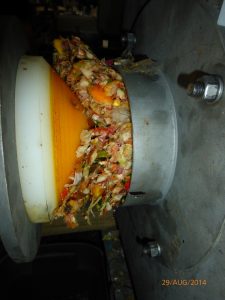
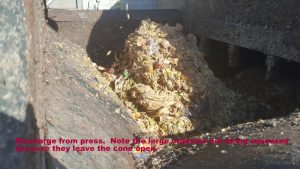
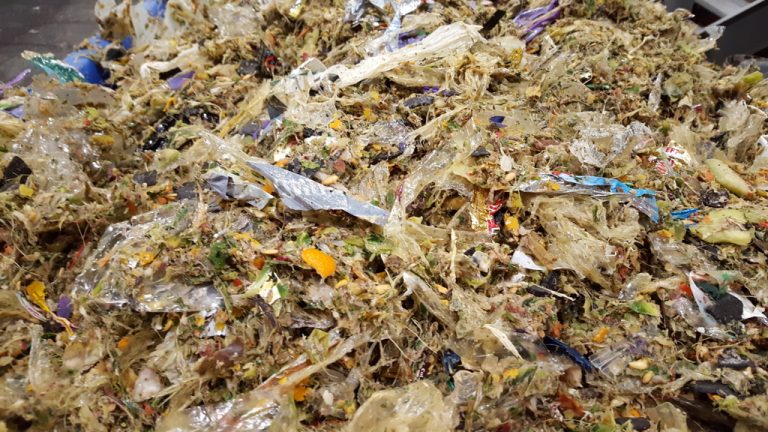
PRESS CAKE
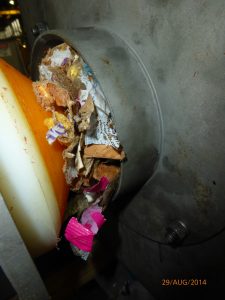
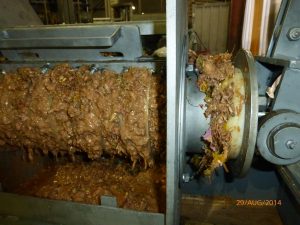
PACKAGING SEPARATION EMULSION COMING THROUGH SCREEN
